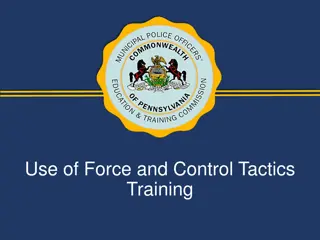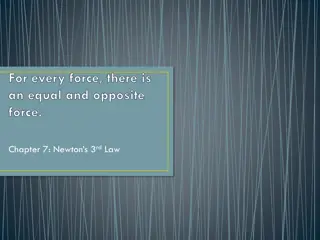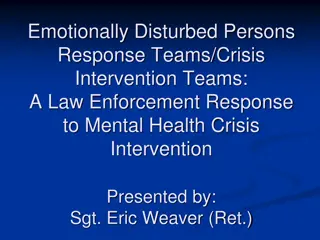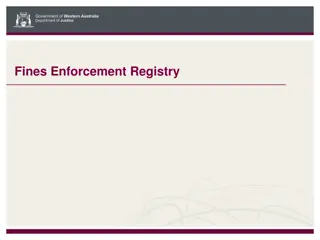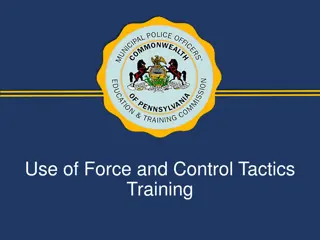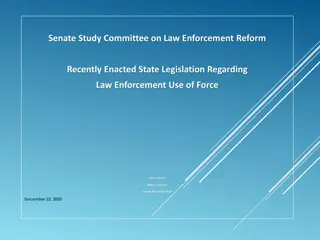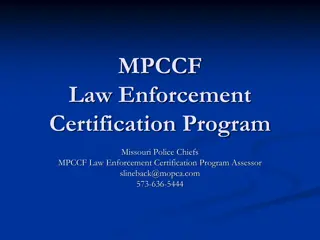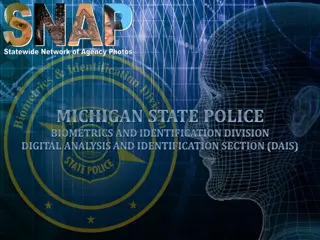Uniform Statewide Deadly Force Policy in Indiana Law Enforcement Training
The Indiana Law Enforcement Training Board has established a consistent and uniform statewide deadly force policy to ensure public safety and promote equity. This policy prohibits modification by any law enforcement agency and emphasizes the sanctity of human life. Officers are required to follow established training programs and use force responsibly. Definitions for terms like chokehold, deadly force, de-escalation, and forcible felony are provided in the policy.
Download Presentation

Please find below an Image/Link to download the presentation.
The content on the website is provided AS IS for your information and personal use only. It may not be sold, licensed, or shared on other websites without obtaining consent from the author.If you encounter any issues during the download, it is possible that the publisher has removed the file from their server.
You are allowed to download the files provided on this website for personal or commercial use, subject to the condition that they are used lawfully. All files are the property of their respective owners.
The content on the website is provided AS IS for your information and personal use only. It may not be sold, licensed, or shared on other websites without obtaining consent from the author.
E N D
Presentation Transcript
UNIFORM STATEWIDE DEADLY FORCE TRAINING UNIFORM STATEWIDE DEADLY FORCE TRAINING INDIANA LAW ENFORCEMENT TRAINING BOARD
Uniform Statewide Deadly Force Policy Uniform Statewide Deadly Force Policy In accordance with IC 5-2-1-1, the Law Enforcement Training Board hereby establishes this consistent and uniform statewide deadly force policy in order to ensure the public safety and general welfare of the people of the state of Indiana and to promote equity for all segments of society. This policy may not be added to, modified, or altered in any way by any Indiana law enforcement agency, office, or department. IC 5-2-1-1: (b) This chapter shall be interpreted to achieve said purposes through the establishment of a consistent and uniform statewide: (1) deadly force policy and training program; (c) However, any policy or program created or implemented pursuant to subsection (b)(1) or (b)(2) may not be modified or altered in any way by any Indiana law enforcement agency, office, or department.
Uniform Statewide Deadly Force Policy Uniform Statewide Deadly Force Policy It is the policy of the LETB to value and preserve the sanctity of human life. Law enforcement officers shall only use force, non-deadly or deadly, in compliance with the law, this policy, and the Board established training program to further an enforcement action. Officers shall use only the force that is objectively reasonable, while protecting the safety of officers and others. Officers shall use only the level of force which a reasonably prudent officer would use under the same or similar circumstances.
DEFINITIONS DEFINITIONS The following definitions correspond to terminology used within this policy and the statewide training program: CHOKEHOLD (IC 35-41-3-3) Applying pressure to the throat or neck of another person in a manner intended to obstruct the airway of the other person. DEADLY FORCE (IC 35-31.5-2-85) Force which creates a substantial risk of serious bodily injury.
DEFINITIONS DEFINITIONS The following definitions correspond to terminology used within this policy and the statewide training program: DE-ESCALATION Actions taken, if safe and feasible to do so, in an attempt to stabilize the situation in an effort to reduce or eliminate the necessity of using force against subjects. FORCIBLE FELONY - a felony that involves the use or threat of force against a human being in which there is imminent danger of serious bodily injury to a human being. FORCIBLE FELONY (IC 35-31.5-2-138) - a felony that involves the use or threat of force against a human being or in which there is imminent danger of serious bodily injury to a human being.
DEFINITIONS DEFINITIONS The following definitions correspond to terminology used within this policy and the statewide training program: SERIOUS BODILY INJURY (IC 35-31.5-2-292) Impairment of physical condition which creates a substantial risk of death or causes serious permanent disfigurement, unconsciousness, extreme pain, permanent or protracted loss or impairment of the function of a bodily member or organ, or loss of a fetus.
DEFINITIONS DEFINITIONS DEADLY WEAPON (IC 35-31.5-2-86) Means the following: 1. A loaded or unloaded firearm. 2. A destructive device, weapon, device, taser (as defined in IC 35-47-8-3) or electronic stun weapon (as defined in IC 35-47-8-1), equipment, chemical substance, or other material that in the manner it is used; could ordinarily be used; is intended to be used; is readily capable of causing serious bodily injury. 3. An animal (as defined in IC 35-46-3-3) which is readily capable of causing serious bodily injury, and which is used in the commission or attempted commission of a crime. 4. Abiologicaldisease, virusororganismwhich is capableofcausingserious bodilyinjury. 5. The term does not include a taser (as defined in IC 35-47-8-3);an electronicstun weapon (as defined in IC 35-47-8-1);a chemical designed to temporarily incapacitate a person; or another device designed to temporarily incapacitate a person; if the device is used by a law enforcement officer who has been trained in the use of the device and who uses the device in accordance with the law enforcement officer's training and while lawfully engaged in the execution of official duties.
DEFINITIONS DEFINITIONS PASSIVE RESISTANCE - a non-forcible act that is intended to impede, hinder, or delay complying with a lawful order or effecting an arrest (e.g., going limp, dead weight, ignoring a lawful command, or holding on to something while disobeying verbal orders to release, wherein no force is directed toward the officer). ACTIVE RESISTANCE - a physical action(s) that prevent(s) an officer from being able to lawfully exercise their duties (e.g., subject walking away after being told to stop, subject fleeing from arrest, or subject tensing/pulling away/breaking officer s grip involving force demonstrated by the individual s use of power, strength, or violence directed at or against the officer).
DEFINITIONS DEFINITIONS Passive resistance may turn into active resistance. For example, holding onto a steering wheel is passive resistance; however, if an officer attempts to remove the hands and the subject reacts by tensing or pulling away using power, strength, or violence, then this becomes active resistance. FORCIBLE RESISTANCE - the use or imminent use of force (non-deadly or deadly) directed toward an officer which interferes with the law enforcement officer s rightful exercise of their duties (e.g., hitting, punching, use of instruments or weapons).
FORCE FORCE Our Fourth Amendment jurisprudence has long recognized that the right to make an arrest or investigatory stop necessarily carries with it the right to use some degree of physical coercion or threat thereof to effect it. Graham v. Connor, 490 U.S. 386 (1989)
USE OF REASONABLE FORCE USE OF REASONABLE FORCE REASONABLE FORCE: A law enforcement officer is justified in using reasonable force if the officer reasonably believes that the force is necessary to enforce a criminal law or to effect a lawful arrest. A law enforcement officer is justified in using reasonable force against any other person to protect the person or a third person from what the officer reasonably believes to be the imminent use of unlawful force.
USE OF DEADLY FORCE USE OF DEADLY FORCE DEADLY FORCE: A law enforcement officer is justified in using deadly force if the officer has probable cause to believe that deadly force is necessary to prevent the imminent threat of serious bodily injury to the officer or a third person or the commission of a forcible felony, and has given a warning, if feasible.
USE OF DEADLY FORCE USE OF DEADLY FORCE Imminent Ready to take place, happening soon; often used of something bad or dangerous seen as menacingly near Merriam-Webster dictionary
FORCE RELATED TO ARREST OR ESCAPE The use of deadly force against persons by officers relating to arrest or escape shall be restricted to the following: The officer has probable cause to believe that the deadly force is necessary: i. to prevent the commission of a forcible felony; or ii. to effect an arrest of a person who the officer has probable cause to believe poses an imminent threat of serious bodily injury to the officer or a third person; and iii. has given a warning, if feasible, to the person against whom the deadly force is to be used.
Deadly Force Tennessee v Garner, 471 U.S. 1 (1985): Garner was fleeing the scene of a burglary. An officer gave chase and Garner stopped at the base of a chain link fence. The officer could see Garner with a flashlight and believed him to be a teenager, saw no sign of a weapon, and figured Garner was unarmed. The officer yelled police, halt and Garner began to climb the fence. The officer shot Garner to prevent his escape and he later died. Tennessee statute allowed officers to use all necessary means to effect an arrest after giving notice of intent to arrest the suspect.
Deadly Force Tennessee v Garner, 471 U.S. 1 (1985): Held: Use of deadly force against an apparently unarmed, fleeing suspect who poses no danger is objectively unreasonable. Where the suspect poses no imminent threat to the officer or others, the harm resulting from failing to apprehend a fleeing suspect does not justify the use of deadly force. While burglary is a serious crime, it is not so dangerous as to automatically justify the use of deadly force. An unarmed suspect who has broken into a dwelling at night should not automatically be considered physically dangerous.
Deadly Force Tennessee v Garner, 471 U.S. 1 (1985): Deadly force may not be used unless necessary to prevent escape of the individual when the officer has probable cause to believe the suspect poses a significant threat of death or serious physical injury to the officer or others.
FORCE RELATED TO ARREST OR ESCAPE The use of deadly force against persons by officers relating to arrest or escape shall be restricted to the following: An officer who has an arrestedperson incustodyis justifiedinusingdeadly force to prevent the escape of the arrested person from custody only if the officer: i. Has probable cause to believe deadly force is necessary to prevent the escape from custody of a person who the officer has probable cause to believe poses an imminentthreat of serious bodily injury to the officer or a third person; and i. Has given a warning, if feasible, to the person against whom the deadly force isto be used.
FORCE RELATED TO ARREST OR ESCAPE A law enforcement officer who has an arrested person in custody is justified in using the same force to prevent the escape of the arrested person from custody that the officer would be justified in using if the officer was arresting that person. A guard or other official in a penal facility or a law enforcement officer is justified in using reasonable force, including deadly force, if the officer has probable cause to believe that the force is necessary to prevent the escape of a person who is detained in the penal facility.
Graham v. Connor Graham v. Connor
Graham v. Connor, 490 U.S. 386 (1989) Graham was a diabetic who asked a friend to drive him to the store for orange juice to counteract an insulin reaction. At the store, Graham quickly saw that the line was too long and hastily entered and then left the store. An officer observing this quick exit, was suspicious of criminal activity and conducted an investigative stop. The friend/driver tells Officer Connor that Graham was suffering from a sugar reaction but Connor orders them to wait until he has investigated for a potential theft or robbery at the store While waiting for back-up, Connor observes Graham exit the car, run around it twice, and pass out. Backup Officer arrives and approaches Graham on the sidewalk, forcibly handcuffing him. Officers grab Graham, carry him to the police car and place him face down on the hood. He is later thrown headfirst into the police car. Officers learn that nothing happened at the store, so they drive him home and release him. Graham suffered a broken foot, cuts on wrist, bruises, and a shoulder injury.
Graham v. Connor, 490 U.S. 386 (1989) The Court developed this standard: To determine if the officer s use of force was reasonable, the Court conducts a careful balancing of the nature and quality of the intrusion on a person s right to be free from unreasonable seizures of their person, against the countervailing government interests at stake. Reasonableness is determined from the perspective of a reasonable officer on the scene (considering the totality of the facts and circumstances known at the time).
Graham v. Connor, 490 U.S. 386, 396 (1989) Because [t]he test of reasonableness under the Fourth Amendment is not capable of precise definition or mechanical application , however its proper application requires careful attention to the facts and circumstances of each particular case, including the severity of the crime at issue, whether the suspect poses an immediate threat to the safety of the officers or others, and whether he is actively resisting arrest or attempting to evade arrest by flight.
Was the seizure reasonable? Claims of excessive force, deadly or non-deadly, during an arrest, investigatory stop, or any seizure of a person are evaluated under this objective reasonable officer standard: Would a reasonable officer on scene, react in a similar manner when faced with the same facts and circumstances known at the time by the officer using force? This officer s underlying intent or motivation will not be considered This standard of reasonableness allows for the fact that police officers are often forced to make split-second judgments in circumstances that are tense, uncertain, and rapidly evolving, about the amount of force that is necessary in a particular situation.
Nature and Quality Nature and Quality of the Intrusion on the Person Nature: type of force Open hand, closed hand, kick, object (flashlight, car, baton), chemical spray, conducted energy weapon/taser, less-lethal, firearm Quality: amount, severity, duration of force Force may become more severe given how many times it is applied, the duration of the application, the pressure behind it, multiple forms, multiple officers
Objective Reasonableness Objective Reasonableness Is the suspect resisting? Is the resistance passive, active, and/or forcible (*demonstrating strength, power, violence)? Does the subject pose an imminent threat to the safety of the officer or others? Is the suspect armed with or have access to a weapon/deadly weapon? Did the suspect indicate an intention to harm the officer or a third person? Has the suspect just committed a crime? How severe is the crime suspected? Does the crime involve injury, SBI or death? Did the suspect charge the officer? Is the subject attempting to flee and presenting an imminent threat of serious bodily injury or death to third-parties?
Objective Reasonableness Objective Reasonableness What was the level of force used by the officer(s)? Was the officer s response proportional? How severely was the force or object applied? How long was force endured?
Proportionality Proportionality It s the totality of the circumstances, not the first forcible act, that determinates objective reasonableness. Circumstances are constantly evolving; facts and threats are being added or reduced so the use of force decision should be constantly evolving as well As the threat level changes, so should the type/ amount of force used Force might become increasingly severe the more times it is applied: one strike and ten strikes have different degrees of severity of force Cyrus v Town of Mukwonago, 624 F.3d 856 (7thCir. 2010)
DEADLY DEADLY FORCE FORCE
USE OF DEADLY FORCE USE OF DEADLY FORCE Remember the standard for the use of deadly force: A law enforcement officer is justified in using deadly force if the officer has probable cause to believe that deadly force is necessary to prevent the imminent threat of serious bodily injury to the officer or a third person or the commission of a forcible felony, and has given a warning, if feasible.
Imminent Threat of Serious Bodily Injury Resistance 1: Officer Voida attempts to handcuff Tom but Tom attacks her, repeatedly hitting her head on the concrete, and stepping on her head. She loses her strength and Tom runs again Resistance 2: Voida continues the chase to arrest him for battery on an officer. She catches him and there is forcible resistance. Tom punches Officer Voida in the face. She cannot reach her chemical spray, so she pulls her gun and pushes herself away. Officer gives three warnings, and the suspect runs at the officer twice with hands raised and arms spread wide Officer shoots and kills him as he runs toward her with arms wide Tom v. Voida, 654 N.E.2d 776 (Ind. Ct. App. 1995)
Imminent Threat of Serious Bodily Injury Evaluation of Objective Reasonableness of the use of deadly force: Deadly force was objectively reasonable given the totality of the circumstances in this case. State s interests in seizure: Initial attempt to handcuff was based on reasonable suspicion of criminal activity, any further use of force was following probable cause to arrest for resisting law enforcement and battery on an officer Deadly force was used only after suspect inflicted serious bodily injury on the officer and continued to pose an imminent threat of additional serious bodily injury when he advanced toward Officer Voida a second time with his arms spread wide, reasonably believed to be a continuation of his attack. Tom v. Voida, 654 N.E.2d 776 (Ind. Ct. App. 1995)
Imminent Threat of Serious Bodily Injury Rickard (driver) led the police on a vehicle pursuit. Attempts to stop the vehicle using a rolling roadblock were unsuccessful. The pursuit at times hit speeds over 100 mph. Rickard was temporarily stopped at one point after hitting a police vehicle, officers approach the vehicle with weapons drawn and Rickard s tires start spinning showing he was hitting the accelerator. Officer fired 3 shots into the car, Rickard then reversed and maneuvered onto another street forcing an officer to step away to avoid being hit. Rickard was fleeing down the street and additional officers fired 12 more shots into the vehicle (15 shots total were fired) Rickard lost control, crashed, and both Rickard and passenger died from injuries. Plumhoff v. Rickard, 572 U.S. 765 (2014)
Imminent Threat of Serious Bodily Injury Henning was questioned in a public location about a report of suspicious activity. During a consensual search of the truck, a gun was found, which was a violation of Henning s probation. Henning made a move away from the officers who were attempting to handcuff him, and several officers attempted to place him in handcuffs and bring him to the ground. Henning continued to fight on the ground. The officers used hand strikes, chemical spray, and a baton. During the struggle, an officer s gun became missing, and a gun was observed under the suspect whose hand was also out of view. Officers testified the suspect s finger reached for the trigger. A warning was given to the suspect. The suspect then started to roll over with hands still not visible. Officer shot the suspect. Henning v. O Leary, 477 F.3d 492 (7thCir. 2007)
Imminent Threat of Serious Bodily Injury The Court held that the use of deadly force was objectively reasonable given the totality of the circumstances in this case: The suspect posed a substantial and imminent risk of serious bodily injury to officers: his hand was at least near a loose gun under his torso, he was continuously actively resisting officers, the officers only moved to deadly force when there was the addition of the officer s firearm under his body near his hand. They issued warnings to Henning and he started to roll over/turn his torso when the officer attempted to reach for the gun. Police officers cannot be expected to wait until a resisting arrestee has a firm grip on a deadly weapon before taking action to ensure their safety Henning v. O Leary, 477 F.3d 492 (7thCir. 2007)
VEHICLE VEHICLE PURSUITS PURSUITS
USE OF POLICE VEHICLE USE OF POLICE VEHICLE Officers shall only use police vehicles as a weapon in situations where deadly force is allowed by law. However, use of a precision immobilization technique (PIT) maneuver, when used in accordance with agency, department or office training guidelines, is not considered deadly force.
Imminent Threat of Serious Bodily Injury REQUIREMENT FOR OFFICER WHO IS NOT PROPERLY TRAINED TO USE PIT: Deadly Force imminent threat of SBI/Death Officer attempted a traffic stop on a vehicle (driven by Harris) for speeding. Harris sped away, on a two-lane road, at a high rate of speed. It was night, there were other cars on the roadway, Harris was crossing into on-coming traffic and cars traveling in both directions were forced to the shoulder to avoid being hit. To end the pursuit, Officer Scott executed a PIT maneuver while Harris was traveling at a high rate of speed, as a result Harris was badly injured. The Court found that it is clear that Harris posed an actual and imminent threat to the lives of many others. Warning was given to Harris prior to application of force. Scott v. Harris, 550 U.S. 372 (2007)
Roadblocks Brower fled from police in a stolen vehicle at night in a high-speed pursuit. Officers set up a roadblock by placing a semi-trailer completely across the highway in the path of flight. Further, the officers concealed the roadblock behind a curve with no illumination, with the headlights of a police vehicle aimed to blind Brower on his approach. The fatal collision ended the chase. Brower v. County of Inyo, 489 U.S. 593 (1989)
Roadblocks Vehicle pursuit policy on roadblocks: Remember that the Statewide Minimum Vehicle Pursuit policy requires that roadblocks must be setup in this way: 1. Use emergency lighting on any authorized emergency vehicle being used 2. The roadblock shall be set up where there is clear visibility to traffic in all directions 3. The subject must be able to see the roadblock and have sufficient time and distance to stop prior toencountering the roadblock
USE OF FORCE USE OF FORCE Officers SHALL NOT: Discharge any warning shot. The objectively reasonable discharge of a firearm in the direction of an individual, against whom deadly force is allowed by law, with the intent to assist an officer or third- party who is in imminent danger, is not considered a warning shot. Discharge a firearm at or from a vehicle except in situations where deadly force is allowed by law.
RESPONSIBILITIES RESPONSIBILITIES OF THE OFFICER OF THE OFFICER UNDER THE UNDER THE STATEWIDE POLICY STATEWIDE POLICY
OFFICER RESPONSIBILITIES UNDER THE STATEWIDE POLICY Officers SHALL NOT: Use force against a person who is merely verbally abusive. Use a chokehold except in situations where deadly force is allowed by law.
DE DE- -ESCALATION ESCALATION De-escalation definition: Actions taken, if safe and feasible to do so, in an attempt to stabilize the situation in an effort to reduce or eliminate the necessity of using force against subjects. An officer shall attempt to engage in de-escalation prior to using force when safe and feasible to do so.
DE DE- -ESCALATION ESCALATION De-escalation is a separately mandated annual in-service training requirement under IC 5-2-1-9(g). Departments shall conduct de-escalation training in accordance with the statute.
DUTY TO INTERVENE A law enforcement officer who is present and observes another officer using force that the officer has reason to know is excessive under the circumstances shall have a duty to intervene when it is safe and feasible to do so. Law enforcement officers who intervene shall immediately report the incident to a supervisor or commanding officer.
DUTY TO INTERVENE Duty to intervene applies equally to supervisory and nonsupervisory officers. An officer who is present and fails to intervene to prevent other officers from infringing on the constitutional rights of citizens is liable under 1983 if that officer had reason to know: 1. excessive force was being used, 2. a citizen has been unjustifiably arrested, or 3. that any constitutional violation was being committed by an officer; and The officer had a realistic opportunity to intervene to prevent the harm from occurring Byrd v. Brishke, 466 F.2d 6 (7thCir. 1972) Yang v. Hardin, 37 F.3d 282 (7thCir. 1994)
LIABILITY FOR FAILURE TO INTERVENE Courts have concluded that only if a reasonable jury could not possibly conclude that the officer could have intervened, would the officer be granted leave from civil liability consequences. Abdullahi v. City of Madison, 423 F.3d 763 (7thCir. 2005). The Court stated A realistic opportunity [to intervene] means a chance to warn the officer using excessive force to stop. Miller v. Gonzalez, 761 F.3d 822 (7thCir. 2014).
DUTY TO INTERVENE: HOW MUST AN OFFICER INTERVENE? Some potential intervention techniques are below. What technique is appropriate to prevent the continued use of excessive force will be based on a totality of the circumstances: Redirection of the officer Verbal intervention Physical intervention Calling supervisor to the scene Physical restraint of the officer * If intervention compromises the safety of the intervening officer, then intervention is not safe or feasible.
DUTY TO INTERVENE DUTY TO INTERVENE Agencies may spend this time discussing proper intervention techniques and scenarios consistent with the Uniform Statewide Policy on Deadly Force.




